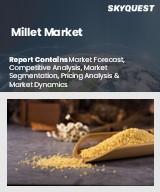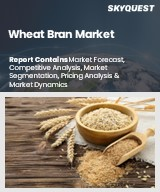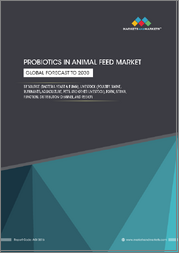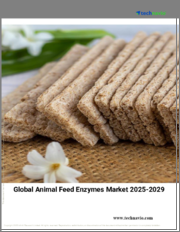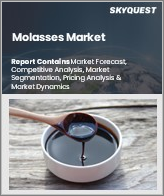
|
시장보고서
상품코드
1577270
동물 사료용 단백 가수분해물 시장, 기회, 성장 촉진요인, 산업 동향 분석과 예측(2024-2032년)Animal Feed Protein Hydrolysate Market, Opportunity, Growth Drivers, Industry Trend Analysis and Forecast, 2024-2032 |
||||||
세계의 동물 사료용 단백 가수분해물 시장은2024-2032년에 CAGR 4.9%를 나타냅니다.
이 시장은 동물, 생선, 식물 및 우유에서 얻은 단백질 가수분해물의 생산 및 유통에 초점을 맞추었습니다. 산 또는 효소에 의한 가수분해에 의해 만들어지는 이러한 가수분해물은 단편화된 단백질 구조로 구성됩니다. 시장 성장의 주요 원동력은 영양가를 높이기 위해 동물 사료의 고품질 단백질 보충제에 대한 수요가 증가하고 있기 때문입니다. 미국 농무부에 따르면 동물 사료에 대한 세계 수요는 매년 3.5% 증가할 것으로 예상되며, 이는 동물 영양학에 대한 중요성을 강조하고 있다(USDA, 2023).
가축 인구 증가, 양식업의 대중화, 반려동물 영양에 대한 관심 증가 등의 요인도 한몫을 하고 있습니다. 또한 현재 진행 중인 연구개발은 단백질 가수분해물의 효능과 적응성을 향상시켜 동물 사료용 단백질 가수분해물 시장의 성장을 가속하고 있습니다. 이해관계자들이 사료 효율과 동물의 건강 상태를 개선하기 위해 가수분해물의 이점을 활용하고자 함에 따라 동물의 성능을 향상시키기 위해 최적화된 사료 배합을 추구하면서 시장의 지속적인 성장에 박차를 가하고 있습니다.
2023년 2억 5,310만 달러로 평가된 산 가수분해 기술 부문은 2032년까지 연평균 5.4%의 성장률을 보일 것으로 예상됩니다. 이 화학 공정은 염산, 황산, 구연산과 같은 산을 사용하여 복잡한 단백질을 더 간단한 펩티드와 아미노산으로 분해합니다. 산 가수분해는 동물 사료에서 단백질의 소화율과 생체 이용률을 높이는 데 매우 중요한 역할을 합니다. 이 기술은 펩티드 결합을 절단하여 더 작고 흡수성이 높은 단백질 조각을 생성하여 가축 및 기타 동물의 영양 흡수를 향상시키고 사료 효율과 전반적인 건강을 개선합니다.
가금류 분야는 2024년 2억 2,580만 달러에 달할 것으로 예상되며, 2024-2032년 6%의 연평균 복합 성장률(CAGR)을 나타낼 것으로 예상됩니다. 이러한 급격한 증가는 이러한 가수분해물이 가금류에 미치는 영양학적 이점에 대한 인식이 높아졌기 때문입니다. 가수분해물이 가금류의 건강과 성장에 도움이 된다는 인식이 높아지면서 수요를 촉진하고 있습니다.
아시아태평양의 동물 사료용 단백질 가수분해물 시장은 2024-2032년 6%의 연평균 성장률(CAGR)을 기록하며 2억 1,870만 달러 규모로 성장할 것으로 예상됩니다. 이러한 성장의 원동력은 이 지역의 축산 및 양식업 부문의 호황과 고급 영양가 높은 사료 원료에 대한 수요 증가에 기인합니다. 가축의 건강, 생산성, 사료 효율성 강화에 대한 관심이 높아지면서 시장은 더욱 활기를 띠고 있습니다. 이 지역의 경제가 발전하고 농업 관행이 현대화됨에 따라 단백질 가수분해물을 포함한 혁신적인 사료 솔루션에 대한 수요는 시장의 지속적인 성장을 가속할 태세를 갖추고 있습니다.
목차
제1장 조사 방법과 조사 범위
제2장 개요
제3장 업계 인사이트
- 에코시스템 분석
- 주요 제조업체
- 유통업체
- 업계 전체의 이익률
- 업계에 대한 영향요인
- 촉진요인
- 시장이 해결해야 할 과제
- 시장 기회
- 새로운 기회
- 성장 가능성 분석
- 원재료 상황
- 제조 동향
- 기술의 진화
- 지속가능 제조
- 그린 프랙티스
- 탈탄소화
- 지속가능 제조
- 원재료의 지속가능성
- 가격 동향(달러/톤), 2021-2032년
- 규제와 시장에 대한 영향
- Porter의 산업 분석
- PESTEL 분석
제4장 경쟁 구도
- 기업 점유율 분석
- 경쟁 포지셔닝 매트릭스
- 전략 전망 매트릭스
제5장 시장 규모·예측 : 기술별, 2021-2032년
- 주요 동향
- 산 가수분해
- 효소 가수분해
제6장 시장 규모·예측 : 가축별, 2021-2032년
- 주요 동향
- 가금
- 브로일러
- 레이어
- 돼지
- 소
- 송아지
- 수산양식
- 연어
- 송어
- 새우
- 기타
- 말
- 애완동물
제7장 시장 규모·예측 : 형태별, 2021-2032년
- 주요 동향
- 파우더
- 페이스트
제8장 시장 규모·예측 : 공급원별, 2021-2032년
- 주요 동향
- 동물성 단백 가수분해물
- 어류 단백 가수분해물
- 식물성 단백 가수분해물
- 유단백 가수분해물
제9장 시장 규모·예측 : 지역별, 2021-2032년
- 주요 동향
- 북미
- 미국
- 캐나다
- 유럽
- 독일
- 영국
- 프랑스
- 이탈리아
- 스페인
- 기타 유럽
- 아시아태평양
- 중국
- 인도
- 일본
- 한국
- 호주
- 기타 아시아태평양
- 라틴아메리카
- 브라질
- 멕시코
- 아르헨티나
- 기타 라틴아메리카
- 중동 및 아프리카
- 사우디아라비아
- UAE
- 남아프리카공화국
- 기타 중동 및 아프리카
제10장 기업 개요
- SOPROPECHE
- Diana Aqua(Symrise Ag)
- Copalis Sea Solutions
- Scanbio Marine Group
- Bio-Marine Ingredients Ireland Ltd.
- Hofseth Biocare ASA
- Janatha Fish Meal and Oil Products
- Drammatic Organic Fertilizer
- 3D Corporate Solutions
- New Alliance Dye Chem Pvt. Ltd.
- Great Pacific BioProducts Ltd.
- Nutrifish
- SAMPI
- SuperFish Fertilizer USA
The Global Animal Feed Protein Hydrolysate Market will show a 4.9% CAGR during 2024-2032. This market focuses on the production and distribution of protein hydrolysates sourced from animals, fish, plants, and milk. Created through acid or enzymatic hydrolysis, these hydrolysates consist of fragmented protein structures. The market growth is primarily driven by the rising demand for high-quality protein supplements in animal feed, aimed at enhancing nutritional content. According to the USDA, global demand for animal feed is set to rise by 3.5% annually, underscoring the heightened emphasis on animal nutrition (USDA, 2023).
Factors such as an expanding livestock population, broader aquaculture practices, and an intensified focus on pet nutrition play a role. Furthermore, ongoing research and development are enhancing the efficacy and adaptability of protein hydrolysates, propelling animal feed protein hydrolysate market growth. The pursuit of optimized feed formulations to boost animal performance is spurring the market's sustained growth, as stakeholders aim to harness hydrolysates' advantages for improved feed efficiency and animal health.
The overall Animal Feed Protein Hydrolysate Market is sorted based on Offering, Deployment Mode, Organization Size, end use , and Region.
The acid hydrolysis technology segment, valued at USD 253.1 million in 2023, is anticipated to grow at a CAGR of 5.4% through 2032. This chemical process employs acids like hydrochloric, sulfuric, or citric acid to decompose complex proteins into simpler peptides and amino acids. Acid hydrolysis plays a pivotal role in boosting protein digestibility and bioavailability in animal feed. By cleaving peptide bonds, this technique yields smaller, more absorbable protein fragments, enhancing nutrient absorption in livestock and other animals, thus improving feed efficiency and overall health.
The poultry segment is projected to reach USD 225.8 million in 2024, with a vigorous CAGR of 6% from 2024 to 2032. This surge is attributed to the growing acknowledgment of the nutritional advantages these hydrolysates provide to poultry. The escalating awareness of their beneficial effects on animal health and growth is thriving demand.
Asia Pacific animal feed protein hydrolysate market is set to grow significantly, targeting USD 218.7 million with a projected CAGR of 6% from 2024 to 2032. This growth is fueled by the region's booming livestock and aquaculture sectors and a rising appetite for premium, nutrient-rich feed ingredients. The emphasis on bolstering animal health, productivity, and feed efficiency further energizes the market. As the region's economy evolves and agricultural practices modernize, the appetite for innovative feed solutions, including protein hydrolysates, is poised to drive continued market growth.
Table of Contents
Chapter 1 Methodology and Scope
- 1.1 Market scope and definition
- 1.2 Base estimates and calculations
- 1.3 Forecast calculation
- 1.4 Data sources
- 1.4.1 Primary
- 1.4.2 Secondary
- 1.4.2.1 Paid sources
- 1.4.2.2 Public sources
Chapter 2 Executive Summary
- 2.1 Industry 360° synopsis
Chapter 3 Industry Insights
- 3.1 Industry ecosystem analysis
- 3.1.1 Key manufacturers
- 3.1.2 Distributors
- 3.1.3 Profit margins across the industry
- 3.2 Industry impact forces
- 3.2.1 Growth drivers
- 3.2.2 Market challenges
- 3.2.3 Market opportunity
- 3.2.3.1 New opportunities
- 3.2.3.2 Growth potential analysis
- 3.3 Raw material landscape
- 3.3.1 Manufacturing trends
- 3.3.2 Technology evolution
- 3.3.2.1 Sustainable manufacturing
- 3.3.2.1.1 Green practices
- 3.3.2.1.2 Decarbonization
- 3.3.2.1 Sustainable manufacturing
- 3.3.3 Sustainability in raw materials
- 3.3.4 Pricing trends (USD/Ton), 2021 - 2032
- 3.3.4.1 North America
- 3.3.4.2 Europe
- 3.3.4.3 Asia Pacific
- 3.3.4.4 Latin America
- 3.3.4.5 Middle East and Africa
- 3.4 Regulations and market impact
- 3.5 Porter's analysis
- 3.6 PESTEL analysis
Chapter 4 Competitive Landscape, 2023
- 4.1 Company market share analysis
- 4.2 Competitive positioning matrix
- 4.3 Strategic outlook matrix
Chapter 5 Market Size and Forecast, By Technology, 2021-2032 (USD Million, Kilo Tons)
- 5.1 Key trends
- 5.2 Acid hydrolysis
- 5.3 Enzymatic hydrolysis
Chapter 6 Market Size and Forecast, By Livestock, 2021-2032 (USD Million, Kilo Tons)
- 6.1 Key trends
- 6.2 Poultry
- 6.2.1 Broilers
- 6.2.2 Layers
- 6.3 Swine
- 6.4 Cattle
- 6.5 Calves
- 6.6 Aquaculture
- 6.6.1 Salmon
- 6.6.2 Trouts
- 6.6.3 Shrimps
- 6.6.4 Others
- 6.7 Equine
- 6.8 Pet
Chapter 7 Market Size and Forecast, By Form, 2021-2032 (USD Million, Kilo Tons)
- 7.1 Key trends
- 7.2 Powder
- 7.3 Paste
Chapter 8 Market Size and Forecast, By Source, 2021-2032 (USD Million, Kilo Tons)
- 8.1 Key trends
- 8.2 Animal protein hydrolysates
- 8.3 Fish protein hydrolysates
- 8.4 Plant protein hydrolysates
- 8.5 Milk protein hydrolysates
Chapter 9 Market Size and Forecast, By Region, 2021-2032 (USD Million, Kilo Tons)
- 9.1 Key trends
- 9.2 North America
- 9.2.1 U.S.
- 9.2.2 Canada
- 9.3 Europe
- 9.3.1 Germany
- 9.3.2 UK
- 9.3.3 France
- 9.3.4 Italy
- 9.3.5 Spain
- 9.3.6 Rest of Europe
- 9.4 Asia Pacific
- 9.4.1 China
- 9.4.2 India
- 9.4.3 Japan
- 9.4.4 South Korea
- 9.4.5 Australia
- 9.4.6 Rest of Asia Pacific
- 9.5 Latin America
- 9.5.1 Brazil
- 9.5.2 Mexico
- 9.5.3 Argentina
- 9.5.4 Rest of Latin America
- 9.6 MEA
- 9.6.1 Saudi Arabia
- 9.6.2 UAE
- 9.6.3 South Africa
- 9.6.4 Rest of MEA
Chapter 10 Company Profiles
- 10.1 SOPROPECHE
- 10.2 Diana Aqua (Symrise Ag)
- 10.3 Copalis Sea Solutions
- 10.4 Scanbio Marine Group
- 10.5 Bio-Marine Ingredients Ireland Ltd.
- 10.6 Hofseth Biocare ASA
- 10.7 Janatha Fish Meal and Oil Products
- 10.8 Drammatic Organic Fertilizer
- 10.9 3D Corporate Solutions
- 10.10 New Alliance Dye Chem Pvt. Ltd.
- 10.11 Great Pacific BioProducts Ltd.
- 10.12 Nutrifish
- 10.13 SAMPI
- 10.14 SuperFish Fertilizer USA








